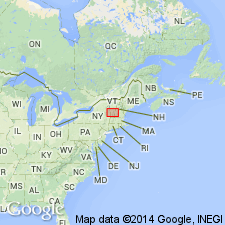
- Usage in publication:
-
- West Castleton Formation*
- Modifications:
-
- Overview
- AAPG geologic province:
-
- New England province
Summary:
In adjacent VT and NY portion of map, used as West Castleton Formation of Proterozoic Z and Early Cambrian age. Mapped undivided with Nassau Formation of same age. [Does not occur in MA.]
Source: GNU records (USGS DDS-6; Reston GNULEX).

- Usage in publication:
-
- West Castleton Formation*
- Modifications:
-
- Areal extent
- AAPG geologic province:
-
- New England province
Summary:
Used as West Castleton Formation of Cambrian age [no explanation given for absence of Late Proterozoic age]. Occurs in Taconic allochthon sequence in Glens Falls quad. Overlies Cambrian Mettawee Formation; underlies Upper Cambrian and Lower Ordovician Hatch Hill Formation.
Source: GNU records (USGS DDS-6; Reston GNULEX).
For more information, please contact Nancy Stamm, Geologic Names Committee Secretary.
Asterisk (*) indicates published by U.S. Geological Survey authors.
"No current usage" (†) implies that a name has been abandoned or has fallen into disuse. Former usage and, if known, replacement name given in parentheses ( ).
Slash (/) indicates name conflicts with nomenclatural guidelines (CSN, 1933; ACSN, 1961, 1970; NACSN, 1983, 2005, 2021). May be explained within brackets ([ ]).

